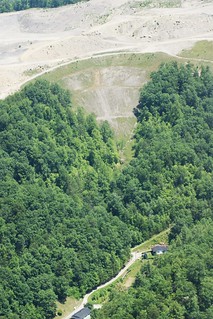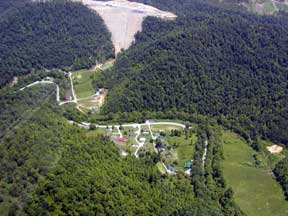Valley fills
The health of a people
 "Growing up in Appalachia, I sometimes drank sweet, pure water that ran over the mountain side, but thanks to practices like mountaintop removal and holler fills, we have people living here today who cannot get clean water from their own taps.
"Growing up in Appalachia, I sometimes drank sweet, pure water that ran over the mountain side, but thanks to practices like mountaintop removal and holler fills, we have people living here today who cannot get clean water from their own taps.
"When we bury our valleys or hollers with overburden, we don't bury some abstract line, we bury and poison cultural identity and life-supporting waterways. Respected physicians and scientific studies have condemned these practices, asserting that they contribute to increases in rates of cancer, birth defects and other health problems. So why aren't our legislators acting on these findings?
"The health of a people depends upon the health of their environment. If it is poisoned, so are we."
Cari Leigh Moore
Knott County
Pollution from
valley fills
Many pollutants leach from the waste in valley fills and degrade local streams. Most disturbing is the presence of selenium and how state officials refuse to hold coal companies accountable for their selenium pollution.
Selenium is a metalloid that, according to the EPA, “can be highly toxic to aquatic life even at relatively low concentrations.” State officials had evidence of selenum in streams below valley fills prior to issuing the General Permit for coal mining in 2009. Yet they did not require monitoring for selenium or include limits on how much can be discharged into streams. State officials have continued their efforts to weaken selenium standards leading up to the renewal of the General Permit in 2014.
 Valley fills are created to dispose of what the coal industry refers to as "overburden." It is hundreds of thousands of tons of rocks, minerals and dirt that once was covered with rich soil, an abundance of plants and bountiful trees. The inside of the mountain is now burying the headwater streams that used to be fed by the life that existed before.
Valley fills are created to dispose of what the coal industry refers to as "overburden." It is hundreds of thousands of tons of rocks, minerals and dirt that once was covered with rich soil, an abundance of plants and bountiful trees. The inside of the mountain is now burying the headwater streams that used to be fed by the life that existed before.
|
"[W]e are burying some potentially valuable and unique habitats without knowing the consequences of our actions.” Dr. Bruce Wallace |
Instead of rolling mountain ridges, we are left with barren mesa's and substandard soil. Through the burial of streams and the lack of plant life we now have major runoff from these fills, carrying off-site and downstream many heavy metals such as selenium and manganese, and increasing the severity and frequency of flooding.
For many years, state and federal officials abetted this destruction with a rubber-stamp process through the U.S. Army Corps of Engineers for granting valley fill permits. Despite volumes of data to the contrary – including some produced by federal agencies themselves – the Corps claimed the rubber stamp permits were justified because valley fills had "minimal environmental impact."
This system changed in 2009 when the Obama administration decided to enforce the Clean Water Act. Through a Interagency Action Plan on Appalachian Surface Coal Mining and other policy changes, the U.S. EPA started blocking dozens of valley fill and related water pollution permits (that Kentucky officials wanted to approve, even though they would violate the law). This has caused great consternation among coal companies that are not used the law being enforced.
Resources:

- Home
- |
- Sitemap
- |
- Get Involved
- |
- Privacy Policy
- |
- Press
- |
- About
- |
- Bill Tracker
- |
- Contact
- |
- Links
- |
- RSS

